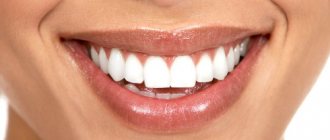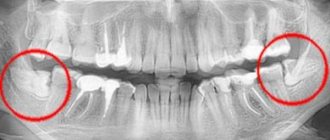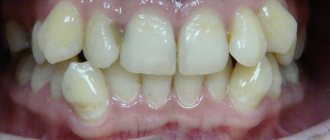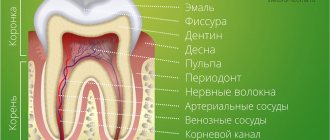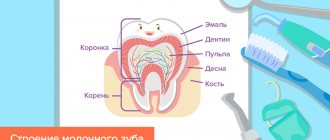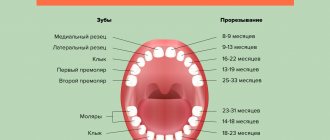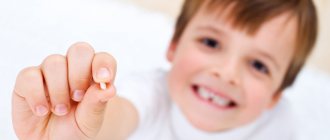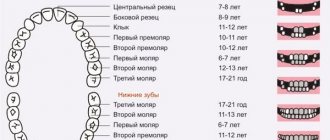About 80% of children have problems with bite. Many parents believe that as the molars grow, this problem will resolve itself. However, this is not true. Children's teeth should be treated from the moment the first symptoms of pathology appear. We will tell you at what age it is better to get braces for a child and how orthodontic treatment occurs.
A child's first teeth begin to erupt at 5-6 months. The bite and condition of a person’s oral cavity in the future depends on how they are formed. All milk teeth (22 units in number) grow by 2.5-3 years. Already at this stage, signs of abnormal tooth growth may be observed. If a child sucks his finger or parents fail to wean him off the pacifier for a long time, dental units begin to grow to the sides. This defect must be corrected immediately, otherwise you will have to spend much more time and money on orthodontic treatment.
In this article
- What time do children get braces?
- What time does a child have plates placed on his teeth?
- Why is it better to give your child braces?
- When is the best time to get braces for your child?
- How to put braces on children
- Getting used to braces
- Caring for your teeth after installing braces
Tooth growth abnormalities can also occur for other reasons. One of the most common of these is tooth decay. Lack of treatment ultimately leads to the need to remove the diseased tooth. At the same time, the dental system continues to form and change. The gap formed after extraction gradually becomes smaller, which occurs due to the displacement of adjacent primary teeth.
Indigenous teeth begin to erupt at the age of 3, and this process is completed by 12-13 years. If the jaw is formed incorrectly, the growing molar will not have free space in the dentition for eruption, as a result of which it will begin to grow to the side, pushing other units apart and causing bite pathologies. They can take different forms. Some of them are outwardly invisible, others, on the contrary, create a noticeable cosmetic defect. However, this problem must be eliminated in both cases.
Due to an incorrect bite, caries often develops, enamel wears off quickly, digestive problems arise, etc. To prevent this, it is necessary to treat all dental diseases in a timely manner. Orthodontic treatment aimed at correcting irregularities in the dentition and malocclusion should also be timely. Let's find out at what age it is better to get braces for a child and how they are installed.
What time do children get braces?
Braces are placed only on molars, which fully erupt by the age of 12-13, and the bite is completely formed. But the development of the dental system will continue until at least 17-18 years. Orthodontic treatment should begin as early as possible, while teeth are more susceptible to external influences, including braces.
In some cases, correction of defects in the dentition has to begin even earlier - at 3-4 years. But at this age, orthodontic braces cannot be installed; they are too heavy for baby teeth. However, braces have an alternative - dental plates.
Until what age can a child’s teeth be straightened?
Parents often ask the question: “At what age should a child’s bite be corrected? / At what age is it better to straighten teeth?”
It is best to have your first consultation with an orthodontist at age 6. Most often, it is at this age that the change of teeth begins: the sixth teeth erupt, the lower first incisors fall out. There are individual differences in the timing of eruption (early/late eruption). This is not a pathology! It is necessary to focus more on the situation in the oral cavity, rather than age.
6-7 years is the peak of a child’s growth, which contributes to the maximum result of orthodontic treatment and psychologically the child will be ready to wear any equipment . BUT! If at an earlier age parents see asymmetries or disproportions of the face, the lower or upper jaw is strongly pushed forward, it is worth going for a consultation with an orthodontist without waiting for 6 years.
Methods for straightening children's teeth vary greatly. It all depends on the specific clinical picture.
Most often, permanent teeth erupt crookedly and crowded due to lack of space for them and narrowing. The aggravation of the situation can be prevented by removable plate devices that stimulate the growth and expansion of the jaws, i.e. create space for teeth and they are aligned.
But straight teeth do not equal correct bite! Bite is the relationship of the jaws relative to each other, their proportional relationship and position in the skull. These parameters can be assessed by an orthodontist in person. Correction of bite in children is carried out using intraoral removable and non-removable plate devices, orthodontic trainers (guards) and extraoral devices. The choice of design is individual.
Remember that preventing pathology is much easier than correcting it in adulthood.
It should be said that orthodontic treatment is often necessary both in the mixed dentition (6-12 years old) and in the permanent dentition (from 13-14 years old). In mixed dentition, devices work to normalize the correct position of the jaws relative to each other, their growth and expansion. The effect on the position of the teeth is not so significant.
Braces/aligners are installed for a child after the eruption of all permanent teeth to completely straighten the teeth and create optimal interdental contacts. Such treatment, after the correct 1st stage at an earlier age, is easier, faster, without complex mechanics of movement.
You can correct an incorrect bite at any age (from 6 years and above), but the earlier you start, the easier it is to achieve maximum and stable results.
What time does a child have plates placed on his teeth?
Plates are orthodontic devices that consist of a plastic or silicone attachment with a metal arch and screws. They are placed on teeth to change their position or direction of growth. Plates will not cure severe pathologies, but they help prevent malocclusion. Plates are placed on children from the age of 3-4, when all the baby teeth grow out. The main indications for prescribing a plate are the following dental problems:
- teeth grow correctly, but there are prerequisites for their displacement;
- they have already begun to change their position, moving to the side;
- the jaw bones develop with any abnormalities.
With the help of a plate, it is possible to correct the situation in time, as well as expand the palate, the dimensions of which determine the formation of the bite. After the child's molars erupt, they can get braces.
Temporary milk bite
A primary dentition is a dentition made up of baby teeth. These teeth received this name because of their milky white color. The eruption of baby teeth begins around 6-8 months (earlier and later eruption is possible).
The appearance of the last baby tooth occurs at about 2 and a half years of age. There are a total of 20 teeth in the primary occlusion - 10 each on the upper and lower jaws. In the primary dentition, space is prepared for future permanent teeth: thus, at the age of about 5 years, the spaces between the incisors widen.
A panoramic image (orthopantomogram) shows not only grown teeth, but also the presence of the rudiments of permanent teeth.
Why is it better to give your child braces?
There are many ways to correct malocclusion, but one of the most common and effective orthodontic treatment methods is wearing braces. They allow you to straighten your teeth much faster than plates or aligners. The child often removes removable structures, as a result of which the effectiveness of treatment decreases. The advantage of braces is that they are permanent, they straighten teeth 24 hours a day, which helps solve the problem faster.
Children can get braces in the following cases:
- any form of malocclusion;
- large or, on the contrary, small interdental spaces;
- differences in development between jaws;
- dysfunction in the masticatory area.
The length of time you wear braces depends on the age at which they were installed and the degree of the disease.
Predicting growth using x-rays of the hand and vertebrae
The development of the dentofacial system correlates with the patient’s age. Skeletal age is determined by the degree of ossification (ossification) of bone structures. During the process of maturation, each bone undergoes changes that are determined radiographically. The sequence of changes is constant for all people.
The degree of growth of the lower jaw can be assessed by the condition of the cervical spine. The assessment is made visually and consists of two parameters: the shape of the vertebra and the presence of concavity at its lower border. The connection between the increase in the length of the lower jaw (body and ramus) and the stage of development of the cervical vertebrae has been scientifically proven.
As a vertebra grows, its shape changes, which makes it possible to assess the degree of maturity. An important point in the analysis is to determine the degree of concavity of its lower surface.
At the very beginning, young immature vertebrae have a rectangular shape. The lower surface of the vertebra is flat or slightly concave. (Fig. 1) Peak growth is expected no earlier than a year after this stage.
As they mature, the vertebrae become increasingly concave on the lower surface, remaining rectangular and horizontal in shape. (Fig. 2) The most active period of growth has already occurred a year or two before this stage.
Upon final maturation, the vertebra acquires a concavity of the lower surface, its shape becomes rectangular, vertical or square. (Fig. 3) This indicates that the peak of growth occurred no later than two years ago before this stage.
The use of this method is relevant when predicting the growth of the lower jaw, for example, when treating with functional devices.
Another method for assessing the degree of growth is an x-ray of the hand. To analyze skeletal maturity up to approximately 9 years of age, the degree of mineralization of the carpal bones, the development of the metacarpal bone and phalanges are used.
The assessment consists of determining the ratio of the sizes of the epiphysis (the widened end of the tubular bone) (Fig. 4) to the diaphysis (the central part of the tubular bone). (Fig.5)
The equal width of the diaphysis and epiphysis is designated as “=” (Fig. 6), the coverage of the diaphysis by the epiphysis in the form of a cap is “cap” (Fig. 7), with complete ossification – “unit(u)” or also “closed (c)” . (Fig.8)
In newborns, signs of carpal bones appear from the 3rd month of life.
An X-ray of a child’s hand is characterized by the “=” and “cap” stages. (Fig.9)
Rice. 9
An x-ray of an adult’s hand is characterized by the “closed” stage. (Fig.10)
Rice. 10
In modern orthodontic practice, determining height using an x-ray of the hand is performed, for example, before orthognathic surgery.
How to put braces on children
Different types of orthodontic braces are installed differently. Vestibular ones are placed on the outer side of the dentition, lingual ones - on the inner side. Children are usually embarrassed to wear braces, so it is better for them to get lingual ones. If they are contraindicated for medical reasons, choose ceramic or sapphire designs that are almost invisible to others.
Braces can be placed on a child only after diagnosis and sanitation of the oral cavity. First, the orthodontist takes photographs and casts of the jaws, according to which the structures are adjusted. After this, he treats all the patient’s dental diseases: gingivitis, caries, etc. Next, professional teeth cleaning is carried out.
Braces are installed in two ways: direct and indirect. In the first case, the locks of the structure are glued to each tooth, in the second, the brackets are assembled on a mock-up and then transferred to the patient’s oral cavity. An arc is threaded through the locks, which is activated immediately after the system is installed. It begins to gradually take the shape that was given to it during manufacturing. Due to this, the teeth are shifted and the bite is corrected.
Getting used to braces
Braces in children and adults immediately after installation or tightening of the arch cause discomfort and pain. These symptoms disappear after a few days, maximum after 2 weeks. During this entire period, you should eat only liquid food.
Subsequently, you will have to give up solid foods, drinks with dyes and food with astringent and sticky ingredients. Otherwise, the risk of developing caries increases. Parents should monitor the child's nutrition. Children often eat chips and drink soda in secret, which can negatively affect the condition of the enamel. You should create a diet for your child, and also teach him to regularly clean his braces.
Caring for your teeth after installing braces
Standard teeth cleaning after orthodontic braces is not enough. Moreover, a child cannot do without additional hygiene products. You need to purchase for him:
- A toothbrush with V-shaped bristles (the hairs in the center are slightly shorter than those on the edges), for example, Curaden International CURAPROX Ortho.
- Brush for cleaning braces. It is a small brush with an oblong head and short bristles. A brush is used to clean the space between the arch and the teeth, as well as around the clasps. Examples of such devices are Coswell SPA Biorepair® Scovolini Monouso in Gomma Regolari and Curaprox CPS 10.
- Dental floss with a hard end. It is advisable to use it after eating fibrous foods: meat, oranges, etc. It is necessary to buy threads that will not tear upon contact with a metal arc: Miradent Mirafloss implant chx and Curaprox implant & braces DF.
- Rinse aid with antibacterial properties and minerals. It helps disinfect the structure and oral cavity, as well as strengthen the enamel. For a child, you can buy both a children’s mouthwash and a product used by adults: DRC ROCS “Active Calcium” or Hager & Werken Miradent paroguard chx.
The brush should be used at least twice a day (in the morning and before bed), the brush and rinse should be used after each meal. As an additional hygiene product, you can use an irrigator with a nozzle for cleaning orthodontic systems: stationary Donfeel Donfeel OR-820D Compact or portable Revyline RL 200XL.
Dentists recommend bringing your child for an examination every 4 months, regardless of whether he has symptoms of dental disease or not. This way, the doctor will be able to identify the first signs of malocclusion in time and immediately prescribe treatment.
